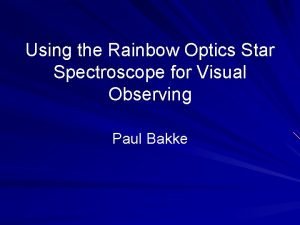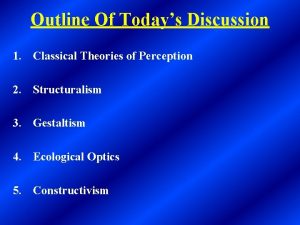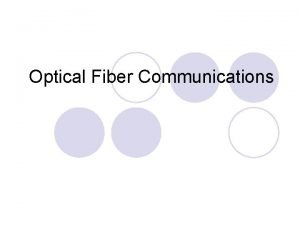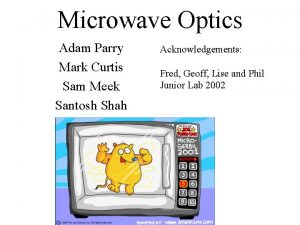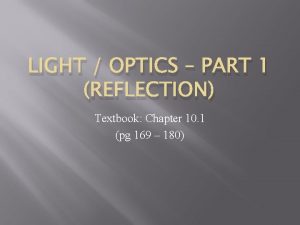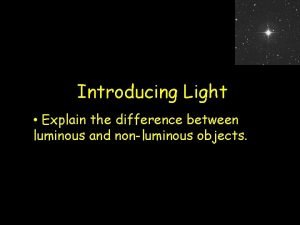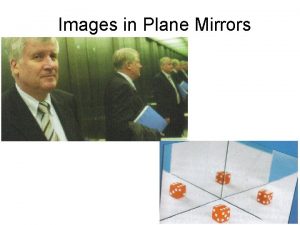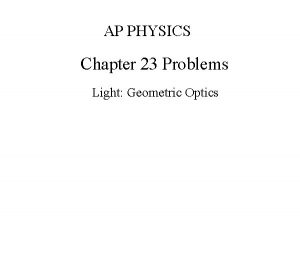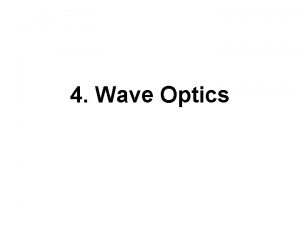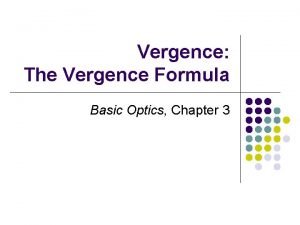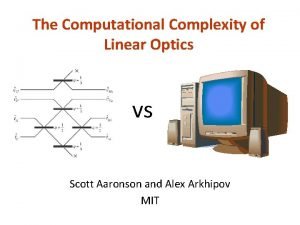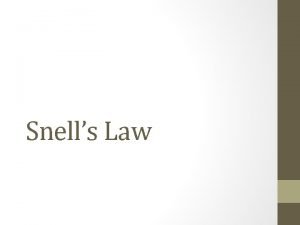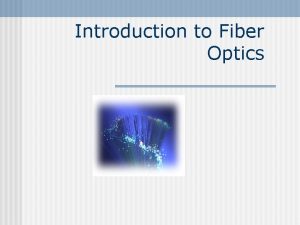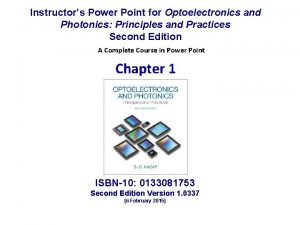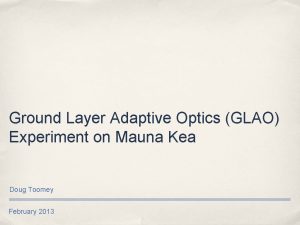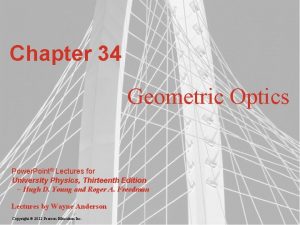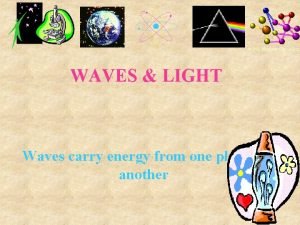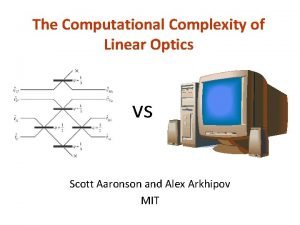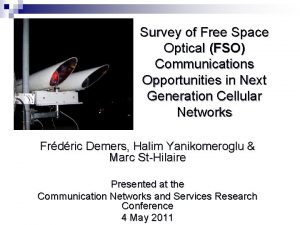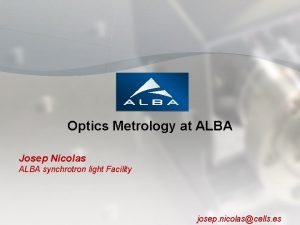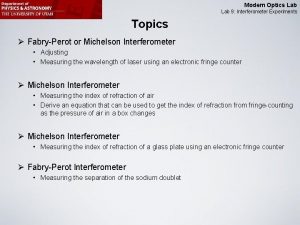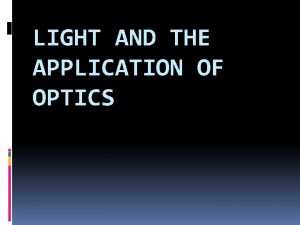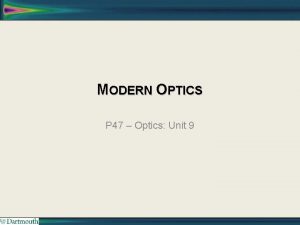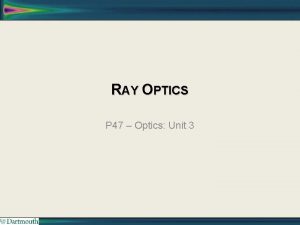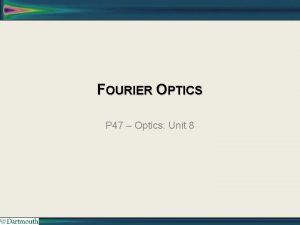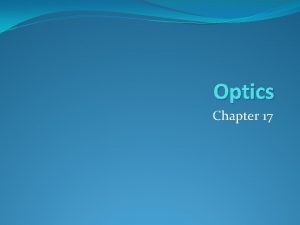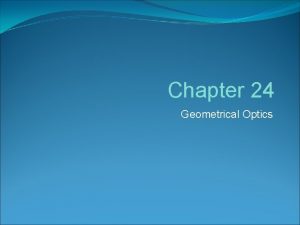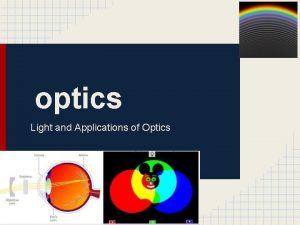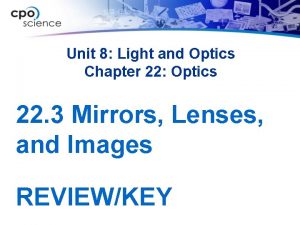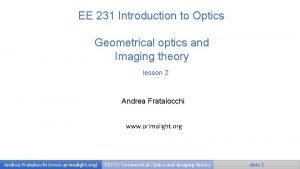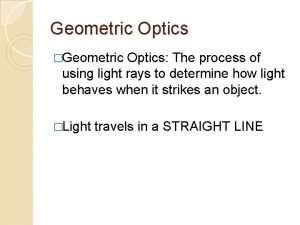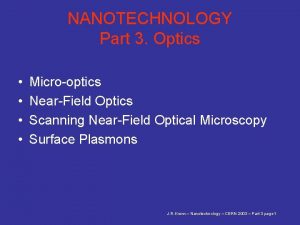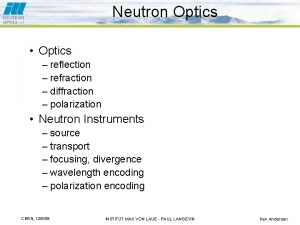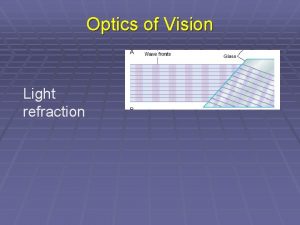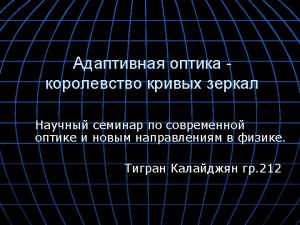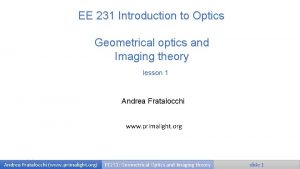Unit 33 Optics is the study of the

































- Slides: 33

Unit 33 - Optics is the study of the behavior and properties of light. This includes it’s interactions with objects including mirrors, lenses, and substances which reflect or scatter light.

When Light Strikes an Object When light strikes an object, the light can be reflected, transmitted, scattered, or absorbed.

Magnification or Reduction

Mirrors reflect light at the same angle it receives it. But, if the mirror is curved… Plane mirror

Mirrors Have you ever gone to the fun house and looked at yourself in the many different mirrors there? Have you ever wondered how the image forms? The image formed is a result of reflection, which you learned about in the previous unit. Plane mirror • There are three types of mirrors: plane, concave, and convex. • A plane mirror is a flat mirror

Plane Mirror • The law of reflection states that the angel of reflection is equal to the angle of incidence. • Incident ray = the incoming ray that approaches the mirror • Angle of incidence = the angle the incident ray makes wit a line drawn perpendicular to the surface of the mirror. • Reflected ray = the ray the mirror reflects from the incident ray. • Angle of reflection = the angel the reflected ray makes with the perpendicular line. Plane mirror

- Reflection and Mirrors Concave Mirrors A mirror with a surface that curves inward like the inside of a bowl is a concave mirror.

Parabolic Mirrors They can reflect the light to a focal point, making it the strongest signal possible. Satellite dishes direct the radiowaves to the antenna which sits at the focal point Parabolic mirrors direct sunlight to a focus to absorb energy and generate electricity.

The Focal Point

Concave Mirrors Ray diagrams show where an image forms and the size of the image. The steps below show to draw a ray diagram.

Concave Mirrors Concave mirrors can form either “virtual images” or “real images”

Convex Mirrors A mirror with a surface that curves outward is called a convex mirror.

Comparing and Contrasting As you read, compare and contrast concave and convex mirrors in a Venn diagram like the one below. Write the similarities in the space where the circles overlap and the differences on the left and right sides. Concave Mirror Convex Mirror Real images Enlarged images Curves inward Virtual images Reduced images Curves outward

Quick Lab – everyone go get a spoon!!! Situation 1 Grab a spoon and hold it close to your face so the back side of the spoon is toward your face, as shown in Figure 33. 1. 4. Observe your image in the spoon and slowly move the spoon away from your face. What do you observe? Is the spoon acting as a concave or convex mirror in this situation? Position yourself on this side of a spoon Fig 33. 1. 4

Convex Versus Concave When the back side of the spoon is facing you, it is acting as a convex mirror. • The image in the convex mirror is upright and always a virtual image. • A virtual image cannot be reflected back onto a screen.

Quick lab - Situation 2 Now, repeat the same procedure but flip the spoon so the scoop part is facing you, as shown in Figure 33. 1. 5. Hold the spoon really close to your eye and slowly move the spoon away from your face. What do you observe? Is the spoon acting as a concave or convex mirror in this situation? Position yourself on this side of a spoon Fig 33. 1. 5

When the front side of the spoon is facing you, it is acting as a concave mirror. • The image in a concave mirror is upright and virtual when the object is inside the focal point. • When the object is outside the focal point, the image becomes a real image and it is inverted. • A real image means that a screen could be placed there and the image would appear. • An inverted image has been flipped upside down. • You may have noticed that sometimes the image in the spoon seemed to get larger or smaller. If an image gets larger, it will have a positive magnification and if the image gets smaller it will have a negative magnification.

Refraction of Light (not reflection) When light rays enter a medium at an angle, the change in speed causes the rays to bend or change direction.

- Refraction and Lenses A lens is a curved piece of glass or other transparent material.

Lenses An object’s position relative to the focal point determines whether a convex lens forms a real image or a virtual image.

Lenses A concave lens can produce only virtual images because parallel light rays passing through the lens never meet.

Asking Questions Question Answer When does refraction occur? When light rays enter a medium at an angle What are the types of lenses? Concave and convex lenses

Light entering the eye first enters through the cornea, where it is refracted and begins to focus the light through the pupil. The pupil will expand during times of low light in order to allow more light to enter the eye. During times of bright light it will contract. When the pupil contracts, the iris gets larger and when the pupil expands, the iris gets smaller. After light passes through the pupil it then enters the convex lens in your eye. This lens focuses the light onto the light sensor cells on the back of your eye called rods and cones which are collected at the retina. The area where the nerve endings come together to form the optic nerve create a blind spot.

Correcting Vision Concave lenses are used to correct nearsightedness. Convex lenses are used to correct farsightedness.

Eye Glasses

Sequencing How You See Objects Light enters the eye. Light focuses on the retina. An image forms. Rods and cones send signals to the brain.

- Using Light Optical Instruments A telescope forms enlarged images of distant objects. Telescopes use lenses or mirrors to collect and focus light from distant objects.

- Using Light Optical Instruments A telescope forms enlarged images of distant objects. Telescopes use lenses or mirrors to collect and focus light from distant objects.

Optical Instruments A microscope uses a combination of lenses to produce and magnify an image.

- Using Light Optical Instruments The lens of the camera focuses light to form a real, upsidedown image on film in the back of the camera.

- Using Light Lasers Laser light consists of light waves that all have the same wavelength, or color. The waves are coherent, or in step.

- Using Light Optical Fibers The floodlight in the swimming pool gives off light rays that travel to the surface. If the angle of incidence is great enough, a light ray is completely reflected back into the water. This complete reflection of light by the inside surface of a medium is called total internal reflection.

- Using Light Optical Fibers Optical fibers can carry a laser beam for long distances because the beam stays totally inside the fiber as it travels.
 Difference between ray optics and wave optics
Difference between ray optics and wave optics Venn diagram of geometric optics and physical optics
Venn diagram of geometric optics and physical optics Unit 6 review questions
Unit 6 review questions Rainbow optics star spectroscope
Rainbow optics star spectroscope Ecological optics
Ecological optics Turba optics
Turba optics Types of optics
Types of optics Microwave optics
Microwave optics Bill nye reflection and refraction
Bill nye reflection and refraction Grade 10 optics review
Grade 10 optics review Physics 241 purdue
Physics 241 purdue Whats a luminous object
Whats a luminous object Characteristics of plane mirrors
Characteristics of plane mirrors Hotwire salisbury nc
Hotwire salisbury nc Http //www.phys.hawaii.edu/ teb/optics/java/slitdiffr/
Http //www.phys.hawaii.edu/ teb/optics/java/slitdiffr/ Optics topics
Optics topics With the rule astigmatism axis
With the rule astigmatism axis Geometric optics problems
Geometric optics problems Fourier optics
Fourier optics Vergence formula optics
Vergence formula optics The computational complexity of linear optics
The computational complexity of linear optics Smells law
Smells law Light energy bill nye
Light energy bill nye Introduction to fiber optics
Introduction to fiber optics Cauchy formula optics
Cauchy formula optics Adaptive optics
Adaptive optics Geometrical optics
Geometrical optics Geometrical optics ppt
Geometrical optics ppt What medical procedure uses fiber optics bill nye
What medical procedure uses fiber optics bill nye The computational complexity of linear optics
The computational complexity of linear optics Fso
Fso Optics
Optics Modern optics experiment
Modern optics experiment Optics
Optics



